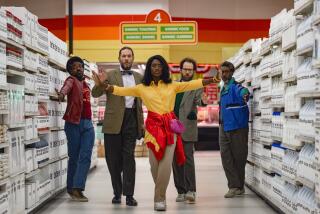Looking for a Maxixe? Try a Tea Dance
- Share via
I was in my teens when “boogie-woogie” became a white-hot fad and we had big hits like “The Boogie-Woogie Bugle Boy of Company B,” “The Boogie-Woogie Washerwoman,” “Cow-Cow Boogie” and dozens of others. Among my old 78s was a number called “Boogie-Woogie Maxixe.”
I’d never seen the word maxixe before, and I was fascinated by it. I can’t think of another word with xix in it. Webster’s New International says that maxixe is properly pronounced “masheesha,” with “makseeks” as a second option.
Like the grizzly bear, the bunny hug and a slew of other dances, the maxixe had its heyday before my time. Those dictionaries say that it is a Brazilian dance in two-four time, resembling the two-step.
I bring it up now because a couple of months ago, at a Sunday afternoon tea dance at the Hollywood Roosevelt Hotel, our friend Marion Zola asked me if I knew what the mashie was. I told her I thought it was a passe term for one of the slope-faced golf clubs. “No,” she said, “it’s a dance. A guy just asked me if I could dance the mashie.”
At last, after all these years, I could actually use the word in a sentence. “He must have meant the masheesha,” I said, suddenly feeling very 1920s continental.
Looking about the dance floor, I noticed a few couples doing what appeared to be a fancy Latin-American version of the two-step. Most of the dancers were just having a ball swinging and stepping about in two-four time, an easy rhythm to fall in with; but the couples who were actually doing the maxixe looked, every one of them, like Fred and Ginger.
Ian Whitcomb leads the orchestra for the Roosevelt’s Sunday tea dances. He’s an English musician, composer and writer. I’ve learned that he was a rock star about 20 years ago, thanks to his smash “You Really Turn Me On,” which is evidently remembered with nostalgic fondness by a great many people who are much younger than I. He abandoned rock after a time and is now a leading authority on ragtime and jazz. He’s just finished writing a book on Irving Berlin.
Tea dancing combined with Whitcomb’s quintessential Britishness reminded me of London in August of 1952, when I found that the local English Palais de Danse advertised their Sunday afternoon The Dansants instead of tea dances. Evidently the Brits thought of tea dances as an exotic continental fancy.
Later, living in France, I was surprised to find that the Parisian dance palaces advertised Tea Dancing , usually pronounced “tea don seeng.” They apparently considered tea dances to be as British as tea and crumpets.
The most recent tea dance we went to at the Roosevelt, last Sunday, was jammed, and, to our delight, jammed with people of all ages, from about 2 to 90--no kidding. And we danced the waltz, the tango, the hokey-pokey, the shag, the foxtrot, “the one-step, two-step, every kinda new step” (I think that’s a line from “I’m a Dingdong Daddy From Dumas, and You Oughta See Me Do My Stuff”).
I asked a couple of young people about the popular dances of their generation. They said there are no identifiable dances; it’s just a question of moving to the beat, sort of ad lib. That, I suppose, is the essence of dance: moving to the beat.
The youngsters I talked with said they were trying some of the more traditional forms of ballroom dance, with some of their exotic rhythms, and thoroughly enjoying them. They looked it, and they looked great.
I wouldn’t be surprised if they started developing new steps, new variations, even new beats, and giving them new names before long. Maybe better than “the grizzly bear”? “the bunny hug”? “truckin’ on down”? “the Susie-Q”?
More to Read
Sign up for The Wild
We’ll help you find the best places to hike, bike and run, as well as the perfect silent spots for meditation and yoga.
You may occasionally receive promotional content from the Los Angeles Times.






